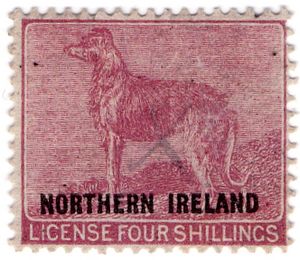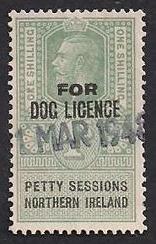Revenue stamps of Northern Ireland facts for kids
Revenue stamps are special stickers or marks that show a tax or fee has been paid. In Northern Ireland, a part of the United Kingdom, these stamps were used for many years. Before 1921, Northern Ireland used stamps from all of Ireland or from the wider United Kingdom.
After Ireland was divided in 1921, Northern Ireland started issuing its own unique revenue stamps. This was important because the taxes collected in Northern Ireland were meant to stay there to help fund local services. These stamps were used until the late 20th century. Most of them looked similar to British stamps but had "NORTHERN IRELAND" written on them.
What Are Key Type Stamps?
Most of Northern Ireland's revenue stamps were what we call "key types." These were standard British stamp designs that were simply overprinted with "NORTHERN IRELAND."
In 1921, stamps were made for many different things, including:
- Bankruptcy (when someone can't pay their debts)
- Civil Service (government workers)
- Companies Registration (starting a business)
- County Courts (local courts)
- Estate Duty (tax on inherited property)
- Dog Licences (permits for owning dogs)
Most stamps from 1921 showed King George V, who was the monarch at the time. However, some older stamps featuring King Edward VII were also used by adding the "NORTHERN IRELAND" overprint.
Later, stamps featured King George VI and then Queen Elizabeth II. Even after 1921, some "IRELAND" stamps were still used, but only in Northern Ireland. In 1971, when money changed to a decimal system (like pounds and pence), new stamps were issued. These included stamps for Dog Licences, which were eventually stopped in 1983.
Other Special Stamps
Besides the "key type" stamps, Northern Ireland also used other types of revenue stamps. Some British or Irish stamps were overprinted to make them valid for Northern Ireland. For example, some British tax stamps and Irish Dog Licence stamps (which showed an Irish wolfhound) were overprinted in the 1920s. Later, in the 1960s and 1970s, many British National Insurance stamps were also overprinted.
Around the 1930s, a special set of tax stamps was issued. These stamps had a unique design featuring the Red Hand of Ulster, a famous symbol of Northern Ireland. These were the only adhesive stamps made specifically for Northern Ireland with their own unique picture.
Northern Ireland also used "impressed duty stamps." These weren't stickers but marks pressed directly onto documents. Many of these showed symbols like the Tudor Crown (a symbol of the UK) and the shamrock (a symbol of Ireland). Some also featured the royal coat of arms of the United Kingdom or the Red Hand of Ulster.
See also
- Revenue stamps of the United Kingdom
- Revenue stamps of Ireland



